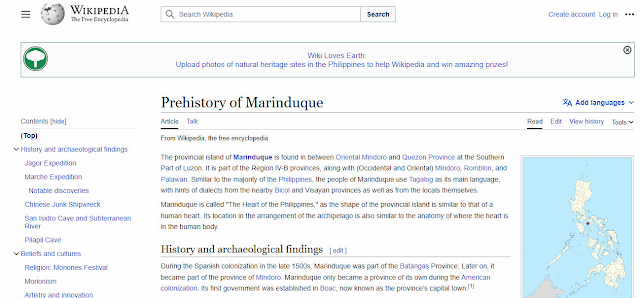This is one of the earliest articles I've written and posted in this blog in 2009 about precolonial Marinduque. It was followed by numerous posts in years that followed that eventually an entry was included in Wikipedia titled PREHISTORY OF MARINDUQUE. Which other provinces or places in the Philippines have been accorded that distinction by Wiki, incidentally? Mukhang wala, nada. And the subject is continuously updated.
The pursuit for cultural discovery in Marinduque continues that many more discoveries have been unearthed since then.
This writer and this website cited as a source.
My Ancient Marinduque
The beginnings of archaeology in the Philippines began right here in Marinduque.
Prior to 1900, only one important archaeological investigation had been carried out in the country: Alfred Marche’s exploration of Marinduque from April to July 1881. While many other accidental finds have been recorded from time to time, and a few burial caves and sites had been casually explored by European or local scientists, no systematic work had been done anywhere else prior to these explorations. After Marche, the next important archaeological work was undertaken by Dr. Carl Gunthe in the Central Visayan Islands in 1922.(Beyer)
"An abundant yield of Chinese urns, vases, gold ornaments, skulls and other ornaments of pre-Spanish origin,” was what the Marche finds represented. He brought back to France in 40 crates the Marinduque artifacts he uncovered. Part of it now said to be housed at the Musee de l’Homme in France. (Solheim). The finds also included wooden images of the Marinduque anito called ‘Pastores’ by the natives.
Part of these artifacts have also found their way into the Smithsonian Institution in Washington, D.C. “Imagine these fragile jarlets traveling from China to the pre-colonial Philippines. Buried in a cave in Marinduque for centuries, they were excavated in the late 19th century, brought to Paris and eventually ended up in a museum bodega outside Washington, D.C. Part of our history lies in museums abroad and it will take sometime to analyze these artifacts to piece together our pre-colonial past” (Ocampo)
 Trivia:"Where do we come from? What are We? Where are we Going?" is the title of a famous Gauguin painting (photo), a life-sized reproduction of which used to hang in my living room before my house was razed to the ground.
Trivia:"Where do we come from? What are We? Where are we Going?" is the title of a famous Gauguin painting (photo), a life-sized reproduction of which used to hang in my living room before my house was razed to the ground.
"An abundant yield of Chinese urns, vases, gold ornaments, skulls and other ornaments of pre-Spanish origin,” was what the Marche finds represented. He brought back to France in 40 crates the Marinduque artifacts he uncovered. Part of it now said to be housed at the Musee de l’Homme in France. (Solheim). The finds also included wooden images of the Marinduque anito called ‘Pastores’ by the natives.
Part of these artifacts have also found their way into the Smithsonian Institution in Washington, D.C. “Imagine these fragile jarlets traveling from China to the pre-colonial Philippines. Buried in a cave in Marinduque for centuries, they were excavated in the late 19th century, brought to Paris and eventually ended up in a museum bodega outside Washington, D.C. Part of our history lies in museums abroad and it will take sometime to analyze these artifacts to piece together our pre-colonial past” (Ocampo)
 Trivia:"Where do we come from? What are We? Where are we Going?" is the title of a famous Gauguin painting (photo), a life-sized reproduction of which used to hang in my living room before my house was razed to the ground.
Trivia:"Where do we come from? What are We? Where are we Going?" is the title of a famous Gauguin painting (photo), a life-sized reproduction of which used to hang in my living room before my house was razed to the ground.


